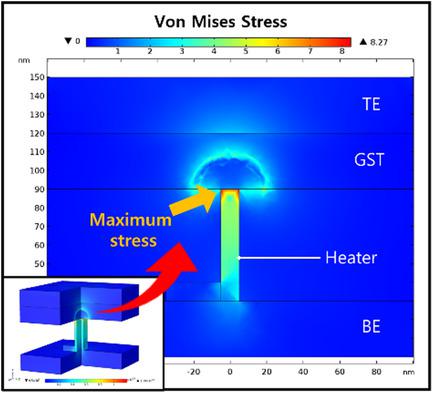当前位置:
X-MOL 学术
›
Phys. Status Solidi. Rapid Res. Lett.
›
论文详情
Our official English website, www.x-mol.net, welcomes your
feedback! (Note: you will need to create a separate account there.)
Analysis of Stuck Reset Failure in Phase‐Change Memory by Calculating Phase‐Change Stress using Finite Element Simulation
Physica Status Solidi-Rapid Research Letters ( IF 2.5 ) Pub Date : 2021-01-18 , DOI: 10.1002/pssr.202000419 Hwanwook Lee 1 , Yongwoo Kwon 1
Physica Status Solidi-Rapid Research Letters ( IF 2.5 ) Pub Date : 2021-01-18 , DOI: 10.1002/pssr.202000419 Hwanwook Lee 1 , Yongwoo Kwon 1
Affiliation

|
Stuck reset is an open‐circuit failure that occurs in phase‐change memory (PCM) after repeated reset and set operations, that is, endurance cycling. Stuck reset is majorly caused by phase‐change stress, which is the mechanical stress induced during a reset operation due to the density difference between the amorphous and crystalline phases of the phase‐change material. This indicates that a reduction in phase‐change stress may improve the endurance characteristics of PCM. Herein, a simulation technique for the calculation of phase‐change stress using a finite‐element software is proposed. Subsequently, a comparative study of the endurance of different PCM device architectures is performed. The results reveal that the self‐heating architecture exhibits superior endurance compared to the heater‐based architecture. Furthermore, the void locations in the experiments coincide with the most highly stressed locations in the simulation.
中文翻译:

通过使用有限元模拟计算相变应力来分析相变存储器中的卡死复位故障
停滞复位是一种开路故障,在反复进行复位和设置操作(即,耐久循环)后在相变存储器(PCM)中发生。卡死复位主要是由相变应力引起的,相变应力是由于相变材料的非晶相和结晶相之间的密度差而在复位操作过程中引起的机械应力。这表明相变应力的减小可以改善PCM的耐力特性。本文提出了一种使用有限元软件计算相变应力的仿真技术。随后,对不同PCM设备架构的耐久性进行了比较研究。结果表明,与基于加热器的体系结构相比,自加热体系结构具有更高的耐久性。此外,
更新日期:2021-03-16
中文翻译:

通过使用有限元模拟计算相变应力来分析相变存储器中的卡死复位故障
停滞复位是一种开路故障,在反复进行复位和设置操作(即,耐久循环)后在相变存储器(PCM)中发生。卡死复位主要是由相变应力引起的,相变应力是由于相变材料的非晶相和结晶相之间的密度差而在复位操作过程中引起的机械应力。这表明相变应力的减小可以改善PCM的耐力特性。本文提出了一种使用有限元软件计算相变应力的仿真技术。随后,对不同PCM设备架构的耐久性进行了比较研究。结果表明,与基于加热器的体系结构相比,自加热体系结构具有更高的耐久性。此外,











































 京公网安备 11010802027423号
京公网安备 11010802027423号